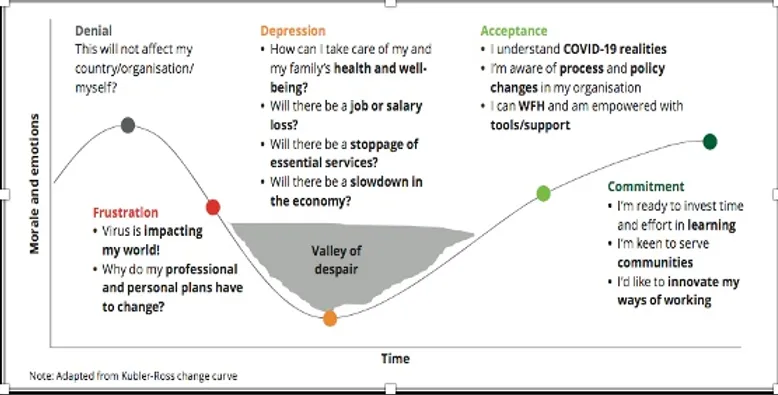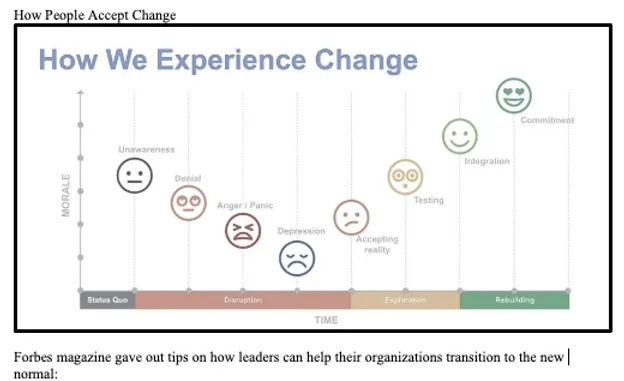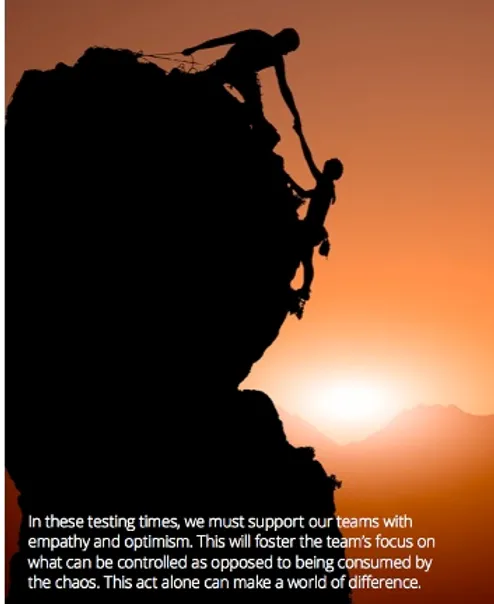
Posted by Seth Hoffman on May 16, 2023

Organizations often have to face the challenges brought about by change. Literature has shown that organizations and its leaders have to deal with current existing business environment, how to manage finances appropriately, how to motivate employees and maximize their talents and contribution, regulations, compliance, new and existing technology challenges and how to market their services to consumers, to name a few. This requires leaders and employees to consistently struggle to work together toward meeting the organizational vision.
Employees of any organization also try to navigate through organizational change and it is a fact that unpredictability result in stress among employees, and it definitely rattles the stability of the organization.


The recent pandemic has brought about unprecedented change among organizations and its most valuable resource: its human resource. The Rand Corporation (2020) states that the devastation that the pandemic has brought about can be summarized into the following:
Rapid spread: The coronavirus, which first started in China and was reported in January, has quickly spread to more than 200 countries, which disrupted everyone’s life. Everyone was caught unaware and this disruption will challenge leaders in today’s world.
Economic uncertainty: In early April 2020, the International Monetary Fund (IMF) said that they anticipate COVID-19 to be the worst economic fallout since the Great Depression. People lost their jobs, were furloughed or have to work at home, or in conditions that otherwise would require working technology, or retraining as well as re- structuring of job functions and responsibilities.
Uncertainty around the pandemic: With the hope yet uncertainty of any vaccination, the stress level of not knowing what will happen next translated from the organization, employees as well as the domino effect on society in general.
The Kubler Ross Stages of Grief is usually used to explain people’s emotions as they go through a negative experience or loss, death or dying. Changes that happen with COVID19 was not necessarily expected and has subjected everyone to go through a transition, the loss of the old normal and the slow and painful process of accepting the new normal. The stages of grief and understanding the process will help predict how people react to negative changes in their lives. Knowing this organizations can help ease that transition by easing the stress that employees go through.
Mindtools (2020) featured an article that states, in a global pandemic usually employ two types of coping. People can either escape or avoid the change and the difficulties associated with the change. Some people will miss meetings, throw away or avoid work related communications, or some will use, drugs, alcohol, basically negative behaviors that would distract them from facing reality. Control coping is being positive and proactive with the change. This is characterized by facing your fears, managing emotions, getting help if they are unmanageable, support others who go through the same change and be a part of the group that accept change.
Change like the pandemic cannot be avoided that, people have to work toward accepting this change. It is a process and it causes stress. The following stages of change was featured in Mindtools and how it relates to emotions of people. Mindtools (2020) also included tips on how people can cope with change.

Stage 1: Shock and Disorientation
People usually feel confused, scared and all emotions rush and seems like it is out of control.
Ask for updates from your manager and HR department, research other people’s similar experiences, and talk through your concerns with family and friends
Be sure to distance yourself from gossip and rumors – they are often baseless and negative, and will likely cause you more pain and anxiety, not less.
Ask yourself the following questions”
Are there potential benefits that you’ve overlooked?
Might an enforced change in your job role allow you to learn a valuable new skill, or to work with new people, for example.
Try to remain as positive as you can.
Stage 2: Anger and Other Emotional Responses: People continue to have mixed emotions.
It’s important to avoid suppressing your emotions, and try to manage them. Recognize and own your emotions and assess what you can express openly (such as general comments about a project’s progress) and what you should probably keep to yourself.
One way of coping with change is to build up your resilience skills.
Stage 3: Coming to Terms With the “New Normal”
The focus will start to shift away from what was lost and toward what’s new. The key here is to make a commitment to move on.
Remember, coming to terms with change is a gradual process.
Talk to others experiencing the same emotions.
Stage 4: Acceptance and Moving Forward
This is the stage when you come to fully accept your changed circumstances. Acceptance doesn’t mean giving up entirely on the past. You’ll have valuable memories, skills and relationships to carry forward, but the point is that you are moving on, whether in your career or in your wider life.
Then set yourself goals and create an action plan to make the most of your new situation.
Manage your stressors and practice self care. Access the Employee Assistance Program as needed. Maximize the use of your support system.

How People Accept Change
Forbes magazine gave out tips on how leaders can help their organizations transition to the new normal:
Communication – The single most impactful thing. Transparency, breeds realistic expectations. People are more likely to accept change that is shared with them than something that totally unexpected.
Be clear, concise, consistent and timely; use multiple methods—both formal and informal.
Encourage use of webcams for meetings and group collaboration tools for more personal connection.
2. Adaptability – as a leader be an example of someone who can flex their style during the change process. Expect frequent and significant changes in employees’ personal situations/priorities, technology access, ability to focus, sentiment.
3. Self-Control – Maintain calm and don’t overshare your own doubt, fear and other negative feelings with colleagues. Practice self-care physically and psychologically. Offer the same to your employees.
4. Relationship Management – Ramp up on informal communications. People are feeling isolated and uneasy.
5. Balance – Be friendly and understanding and show concern for personal impacts without getting too personal.
Organizational management is definitely during COVID19. I believe that in this class there is no one specific concept or idea that is more important or interesting than the other. I believe that his class have given a great birds eye view on how leaders and employees can work together toward the betterment and achievement of the goals of the organization. As a student who will be a part of the workforce in the near future, I believe that we have to prepare ourselves with being able to accept the unexpected. Looking to mentors, friends and leaders who are able to guide us during such crucial times is a must to prepare ourselves to withstand the challenges of time.
As a student and athlete, navigating through COVID19 was quite unnerving. I went through the stages of change. I was excited to start on the new baseball season, and I was eager to start the semester. We were informed of the Pandemic while the baseball team was in Florida. My parents immediately pulled me out of school, packed my belongings and after several cancelled flights, and drive from Nebraska to back to Las Vegas, everything seemed so surreal. The social distancing, the constant bombardment of news media, the panic around me and people losing their jobs, caused some anxiety in my life. I hung out with my friends a lot and focused on school. I also took summer classes and spend most of my time hiking. It was during my hikes that I was able to reflect on what is to become the new normal as an athlete, a student, and as a human being. During this semester, I have been asked to quarantine three times, asked not to show up for practice and basically isolate myself. I do not think that people who make the laws and school policies understand how students are having a hard time in dealing with their own personal challenges, the hurdle of dealing with being socially isolated, and just having so many disruptions in our daily life, worst of all the fear of getting sick. I was behind several times with my school work. Having to pack 4 times during the course of 112 weeks, find a place to stay, get tested, waiting for the results, can easily disrupt our focus on school work. Communicating with faculty I think helped a lot. While processing the constant uncertainty and jumping through hoops, I believe that the faculty have been quite understanding of students at DU. I am glad that the school promotes “caritas” or the caring principle, with an understanding that people, students, are navigating through rough waters, and with a little understanding and mentoring, students have a better chance to be successful.
References:
Belyh, A. (2020). Understanding the Kubler Ross Change Curve. Accessed from https://www.cleverism.com/understanding-kubler-ross-change-curve/
Gunderson, G. (2020). Managing Change And Business Disruption Post-COVID. Accessed from https://www.forbes.com/sites/garrettgunderson/2020/08/22/managing-change-and-business-disruption-post-covid/?sh=2334ae457387
Mindtools, (2020). Coping With Change Facing Fear and the “New Normal.” Accessed from https://www.mindtools.com/pages/article/coping-with-change.htm
Vanscoy, H. (2020). Tips with coping with organizational change. Accessed from https://psychcentral.com/lib/tips-for-coping-with-organizational-change/
Wanberg, C., Borbala, C., Douglass, R., Zhou, L. and Pollard , M. (2020). Socioeconomic Status and Well-Being During COVID-19. Accessed from https://www.rand.org/pubs/external_publications/EP68323.html
Zurich (2020). COVID-19 Risks Outlook: A Preliminary Mapping and its Implications. Accessed from https://www.zurich.com/knowledge/topics/global-risks/covid-19-risks-outlook